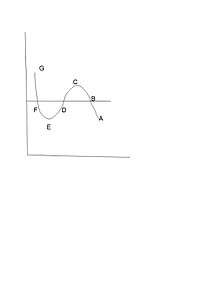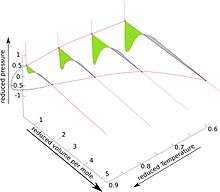Maxwell construction

In thermodynamic equilibrium, a necessary condition for stability is that pressure does not increase with volume . This basic consistency requirement—and similar ones for other conjugate pairs of variables—are sometimes violated in analytic models for first order phase transitions. The most famous case is the Van der Waals equation for real gases, see Fig. 1 where a typical isotherm is drawn (black curve). The Maxwell construction is a way of correcting this deficiency. The decreasing right hand part of the curve in Fig. 1 describes a diluted gas, while its left part describes a liquid. The intermediate (rising) part of the curve in Fig. 1 would be correct, if these two parts were to be joined smoothly—meaning in particular that the system would remain also in this region spatially uniform with a well defined density. But this is not what happens. If the volume of a vessel containing a fixed amount of liquid is expanded at constant temperature, there comes a point where some of the liquid boils and the system consists of two well separated phases. While this two-phase coexistence holds as the volume continues to increase, the pressure remains constant. It decreases again, after all liquid is evaporated and the gas expands. Thus the sinusoidal part of the isotherm is replaced by a horizontal line (red line in Fig. 1). According to the Maxwell construction (or "equal area rule"), the height of the horizontal line is such that the two green areas in Fig. 1 are equal.
The direct quote from Clerk-Maxwell which became the Maxwell construction:
“Now let us suppose the medium to pass from B to F along the hypothetical curve BCDEF in a state always homogeneous, and to return along the straight line path FB in the form of a mixture of liquid and vapour. Since the temperature has been constant throughout, no heat can have been transformed into work. Now the heat transformed into work is represented by the excess of the area FDE over BCD. hence the condition which determine the maximum pressure of the vapour at given temperature is that the line BF cuts off equal areas from the curve above and below.

”
The van der Waals gas equation (using reduced variables) can be expanded [1] to
which is of the form
To solve this cubic equation Cubic function one defines several precursor terms :
and
so that the following become defined
and
The first root’s precursor form is:
leading to
and
and finally
These last four equations depend on two variables, the temperature which is chosen when one determines which isotherm one is working on, and the pressure. One starts with a arbitrary (but reasonable) chosen value and adjust its values as one solves the equation (below) ultimately been obtaining or through the Maxwell construction (see below) at that temperature. With these two variables in hand, one can re-substitute the pressure value obtained into the root equations (above) to obtain the three roots. A complete example with spreadsheet can be found at.[2]
The Maxwell construction requires solution of the equation (obtained by making the areas under the two loops equal and opposite in value from each other):
with a fixed reduced temperature and the solution depending then on the chosen variable reduced pressure, which becomes the reduced vapor pressure. Unfortunately, this equation can not be solved analytically, and requires numerical evaluation. The subscripts in this equation are and have been changed to make clear which two roots of the cubic are to be employed; these roots themselves depend on the equations which precede them (above), and contain the reduced pressure and temperature which are treated as above.
The Maxwell construction (

a new diagram showing details of the construct is at [3]) is rarely derived from the condition that the Gibbs free energies of the gas and the liquid must be equal when they coexist. However, it can be shown that this condition is fulfilled.[4] Essentially the same applies to any other thermodynamic system, where and are replaced by a different pair of conjugate variables, e.g. magnetic field and magnetization or chemical potential and number of particles.
See also
References
- ↑ David, Carl W., "The van der Waals Equation as a cubic" (2015). Chemistry Education Materials. Paper 88. http://digitalcommons.uconn.edu/chem_educ/88
- ↑ David, Carl W., "Plotting the van der Waals Fluid in pseudo-3D and the Maxwell Construction" (2015). Chemistry Education Materials. Paper 89. http://digitalcommons.uconn.edu/chem_educ/89
- ↑ David, Carl W., "Revisiting the FencePlot for the Maxwell Construction of a van der Waals Fluid" (2016). Chemistry Education Materials. Paper 95. http://digitalcommons.uconn.edu/chem_educ/88
- ↑ David, Carl W., "Is the Maxwell construction correct in predicting the van der Waals fluid's vapor pressure?" (2016) http://digitalcommons.uconn.edu/chem_educ/93
- Maxwell, J. C. (1875). "On the Dynamical Evidence of the Molecular Constitution of Bodies.". Nature. 11: 357–359. Bibcode:1875Natur..11..357C. doi:10.1038/011357a0.
- Reichl, L. E. (2009). A Modern Course in Statistical Physics (3rd ed.). New York, NY USA: Wiley-VCH. ISBN 9783527407828.